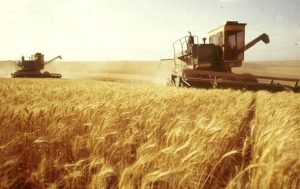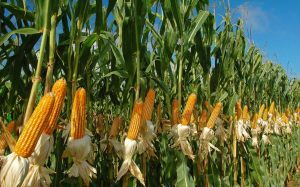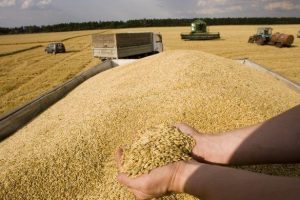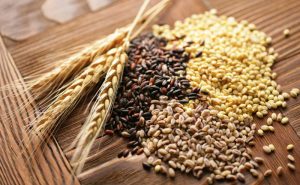
In 2020, Ukrainian agricultural producers harvested 65.4 million tonnes of cereals and legumes from an area of 15.3 million hectares. The operational data of the regions on the results of the harvesting campaign was announced on Tuesday by Minister of Development of Economy, Trade and Agriculture Ihor Petrashko.
According to a report on the ministry’s website, in particular, 25.1 million tonnes of wheat from 6.6 million hectares and 29.8 million tonnes of corn from 5.3 million hectares were harvested.
According to the State Statistics Service, in 2019 Ukraine harvested 75.1 million tonnes of cereals and legumes (70.1 million tonnes in 2018), of which 28.3 million tonnes of wheat (24.6 million tonnes) and 35.9 million tonnes of corn (35.8 million tonnes a year earlier).
“This year, the gross grain harvest amounted to 65.4 million tonnes, which is three times more than the needs of the domestic market, and also allows us to maintain a leading position in the export of agricultural products,” Petrashko said, commenting on the harvest results.
The Ministry for Development of Economy, Trade and Agriculture said that the barley harvest this year was tentatively 7.8 million tonnes threshed from 2.4 million hectares (in 2019, according to the State Statistics Service, 8.9 million tonnes from 2.6 million hectares).
In addition, 516,200 tonnes of peas were harvested from an area of 237,700 hectares (573,000 tonnes from 253,400 hectares), 106,500 tonnes of buckwheat from 78,500 hectares (85,000 tonnes from 69,200 hectares), and 244,000 tonnes of millet from 150,400 hectares (169,700 tonnes from 93,300 hectares).
The sunflower harvest this year preliminary amounted to 13.1 million tonnes from 6.4 million hectares (15.3 million tonnes from almost 6 million hectares), rapeseed – 2.6 million tonnes from 1.1 million hectares (3.3 million tonnes from 1.3 million hectares) and soybeans – 2.8 million tonnes from 1.3 million hectares (3.7 million tonnes from 1.6 million hectares).
Farmers also harvested 9.2 million tonnes of sugar beet from 216,000 hectares, compared with 10.2 million tonnes from 221,000 hectares last year.
The minister explained the decline in the harvest of most crops by atypical weather conditions, but stressed that traditionally agricultural production in Ukraine has a surplus.

The Ukrainian Agribusiness Club (UCAB) has revised downward the forecast for the corn harvest this year from 32 million tonnes to 29.4-29.5 million tonnes under the optimistic scenario due to unfavorable weather conditions during July-August, and also taking into account the situation with harvesting in September and October in a number of regions of Ukraine.
According to a message from UCAB on Wednesday on Facebook, about 13 million tonnes of corn have already been harvested with an average yield of 5.18 tonnes per ha, in some regions corn has already been harvested from more than 50% of the sown area.
“Usually, farmers start harvesting first from less productive fields, so there is some hope, as well as statistical confirmation from the example of last year, when at the end of the harvest, the yield increases slightly. By the end of field work, according to optimistic forecasts, an average yield of 5.75 tonnes per ha is expected,” UCAB said.
According to the Ukrainian Agribusiness Club, unfavorable conditions have developed almost throughout the entire territory of Ukraine, however, the greatest reduction in the expected yield occurred in Cherkasy, Vinnytsia, Poltava, Kirovohrad and a number of southern regions. As a result of dry conditions and a lack of moisture in the soil, premature drying and maturation of plants is observed. During field surveys, insufficient fullness and relatively small sizes of corn ears are often detected.
UCAB’s expectations for the sunflower harvest have been reduced to 12.2 million tonnes from the forecast of 13.6 million tonnes in early September. According to calculations, the average yield is 2.2 tonnes per ha. The largest decline was due to the southern regions, where the production of this oilseed is focused, as well as the central ones.
According to UCAB, soybeans also suffered significantly from unfavorable conditions, so its gross yield is expected to be only 2.7 million tonnes, which is 30% less than last year. This significant decrease occurred, among other things, due to a decrease in the area under crops from 1.6 to 1.3 million hectares.

The National Bank of Ukraine (NBU) expects a grain harvest in 2020 at the level of 70 million tonnes instead of the projected 70-72 million tonnes, Deputy Governor of the NBU Dmytro Sologub has said.
“We predicted that Ukraine will harvest 70-72 million tonnes of grain. Given the rather significant revision of data on the harvest of early grains (wheat and barley) downward compared to the recent statistics, at the moment we expect about 70 million tonnes,” he said in an exclusive interview with the Interfax-Ukraine agency.

Minister of Economic Development, Trade and Agriculture Ihor Petrashko considers it unlikely that the forecast for 2020 for the grain harvest in Ukraine will be revised downward.
“At the beginning of April, we forecasted… 72 million tonnes for grains. Now, assuming that wheat and sunflower harvesting has been completed, and corn harvesting begins, the forecasts, unfortunately, will be lower. We believe that there will be 68 million tonnes. Probably, there will be no more active revisions,” the minister said, answering a question from Interfax-Ukraine at a press conference held at the news agency on Tuesday.
As reported, the Ministry of Economic Development, Trade and Agriculture lowered the forecast for the grain harvest in 2020 from 70 million tonnes to 68 million tonnes due to lower indicators for corn. Thus, the ministry predicts the corn harvest in 2020 at 33 million tonnes.

The Ukrainian Grain Association (UGA) in its September report lowered the forecast for the gross harvest of grains and oilseeds this season from 96.7 to 95.6 million tonnes, exports from 58.4 to 56.3 million tonnes due to unfavorable weather conditions for the harvest of late crops in some regions of Ukraine.
“Even after lowering the forecast for the harvest, its figure may be the second in terms of gross harvest after last year’s record – 98 million tonnes, the same can be said about the possible export volumes,” the association said in a press release posted on its website on Wednesday.
So, this year, according to UGA, farmers harvested 26.6 million tonnes of wheat (UGA forecast was at 26.8 million tonnes) and 8.3 million tonnes of barley (UGA predicted 8.2 million tonnes). According to the association’s forecasts, wheat exports this season may reach 17.5 million tonnes (in accordance with the signed memorandum), and barley may reach 4.5 million tonnes.
In addition, UGA slightly lowered its forecast for the corn harvest this season in the September report compared to the previous forecast in August from 36.4 million tonnes to 35.3 million tonnes due to unfavorable dry weather conditions in the southern and partly central regions of Ukraine.
According to UGA experts, farmers will not harvest corn for grain on an area of 205,000 hectares, which is 3.8% of the total area under corn. In other regions, which are the main corn producers, the harvest situation is satisfactory and good, and they are not experiencing critical losses.

The Ukrainian Grain Association (UGA) in the April report updated its forecast for the harvest of grain and oilseeds in the 2020/2021 marketing year (MY) compared to March, to 94 million tonnes from 92.6 million tonnes.
According to the association’s Thursday press release, the forecast for grain and oilseeds exports for next season is also increased from 55.6 million tonnes to 57.2 million tonnes.
According to the association, in the current marketing year, Ukraine produced 98 million tonnes of grain and oilseeds, exports can reach 60 million tonnes.
The association said that a slightly decrease in the forecast for the harvest of grain and oilseeds in 2020 does not change the upward trend of the last three years, when Ukraine harvested more than 90 million tonnes. In the medium term, gross harvest in the country will approach 100 million tonnes and will continue growing.
The forecast for the harvest and export of wheat in the next marketing year has not changed compared to the March report and will reach 25.8 million tonnes and 18 million tonnes, respectively.
The association said that in 2019, Ukraine had a record-hitting wheat harvest of 28.2 million tonnes, and exports, according to its estimates, will reach 20.2 million tonnes in the 2019/2020 marketing year.
The forecast for corn harvest in the April report of the association increased from 34.3 million tonnes to 36.8 million tonnes, and export for the next season from 27.5 million tonnes to 30 million tonnes. Thus, Ukraine in the 2020/2021 marketing year may break its own record for the current marketing year, when 35.2 million tonnes were harvested with an expected export of about 28.5 million tonnes, the association said.
At the same time, the association decreased the forecast for barley harvest compared to the previous month forecast from 7.96 million tonnes to 6.8 million tonnes, and export for the next season from 4.5 million tonnes to 3.5 million tonnes.
According to its estimates, in the current marketing year in Ukraine, some 9 million tonnes of barley were grown with the planned export of about 4.6 million tonnes.
The Ukrainian Grain Association is an association of producers, processors and large exporters of grain, which annually export about 90% of Ukrainian grain products.